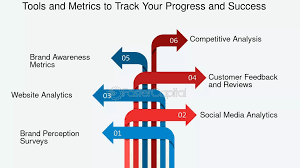Introduction
In the bustling digital landscape of London, where businesses thrive on their online presence, web design plays a critical role. Whether it's a sleek portfolio, an e-commerce platform, or a content-heavy blog, successful web design is far more than aesthetic appeal—it's about results. But how do top London agencies evaluate whether a design is truly performing? This article delves into the key metrics, tools, and techniques used by web design agencies in London to measure success. Whether you're searching for "web designers near me" or managing your own online presence, understanding these metrics can help ensure your website meets both visual and business goals.
1. Defining Web Design Success
1.1 Beyond Looks: Function Meets Form
Web design success isn’t just about how a site looks; it’s about how it performs. London-based agencies often define success based on a blend of user engagement, conversion rates, and SEO performance. A visually stunning website that fails to drive conversions is considered a failure in today’s competitive digital environment.
1.2 Client Goals as Benchmarks
Every web project begins with client objectives. Whether it’s increasing leads, improving user engagement, or enhancing mobile usability, these goals serve as benchmarks for performance. Agencies align their tracking systems with these client KPIs (Key Performance Indicators) from day one.
2. Key Metrics Used by London Web Design Agencies
2.1 Bounce Rate
A high bounce rate often signals poor design or UX issues. London agencies closely monitor how many users leave a website after viewing only one page. A bounce rate above 50% can be a red flag—especially for landing pages or e-commerce sites.
2.2 Conversion Rate
This is the gold standard metric. Whether it’s signing up for a newsletter, filling out a contact form, or making a purchase, conversion rates help determine if the site design is leading users to act.
2.3 Average Session Duration
Agencies analyze how long visitors stay on a website. Longer sessions typically indicate that users are finding the content and structure engaging, which is often the result of smart UX and content placement.
2.4 Click-Through Rate (CTR)
The CTR measures how often users click on calls to action, internal links, or menu items. High CTRs suggest that design elements are effectively guiding users through the desired journey.
2.5 Mobile Responsiveness Score
With mobile traffic dominating the web, responsive design is non-negotiable. London web designers use tools like Google Mobile-Friendly Test to ensure their sites adapt well across all devices.
3. Tools and Technologies Used
3.1 Google Analytics
Almost every agency in London uses Google Analytics to track core user behaviors—pageviews, session duration, bounce rates, and traffic sources. It's the backbone of web performance reporting.
3.2 Hotjar and Crazy Egg
For visual feedback, agencies turn to tools like Hotjar and Crazy Egg. These platforms offer heatmaps and session recordings that reveal where users are clicking, scrolling, or dropping off.
3.3 A/B Testing Tools
Tools such as Optimizely and Google Optimize help London agencies test design variations. By comparing two versions of a webpage, they can scientifically determine which design performs better.
3.4 Lighthouse and PageSpeed Insights
Performance and speed are critical. These tools help designers analyze load times and identify areas for improvement. Fast-loading pages contribute directly to better user experience and SEO rankings.
4. SEO and Web Design: A Synergistic Relationship
4.1 SEO as a Design Metric
Agencies in London understand that good web design also needs to be SEO-friendly. They measure success by how well the site ranks for target keywords, such as "web designers near me" or "web design in London."
4.2 On-Page Optimization
From image alt text to header tags and site structure, agencies optimize every design element for search engines. An attractive site that no one can find is virtually useless.
5. User Experience (UX) Metrics
5.1 Usability Testing
Before launch, agencies often run usability tests. Real users are asked to navigate the site, complete tasks, and provide feedback. The insights gained can lead to critical design tweaks.
5.2 Net Promoter Score (NPS)
Some agencies use NPS surveys to gauge user satisfaction. Would users recommend this site to others? A high NPS indicates strong user experience and satisfaction.
6. Post-Launch Analysis and Reporting
6.1 Monthly Performance Reports
After launching a website, most London agencies offer monthly reporting. These reports analyze all tracked metrics, compare them to previous periods, and suggest optimizations.
6.2 Continuous Improvement Cycle
Web design is never a one-and-done job. Agencies implement an ongoing cycle of tracking, analysis, and updates. This agile methodology ensures the website evolves with user needs and market changes.
7. Client Education and Collaboration
7.1 Explaining the Metrics
Not all clients are data-savvy. Leading agencies invest time in educating clients about what each metric means, why it matters, and how it affects their bottom line.
7.2 Co-Ownership of Results
By fostering a collaborative relationship, agencies empower clients to take ownership of their site’s performance. This ensures shared accountability and ongoing engagement.
8. The Local Touch: Why "Web Designers Near Me" Matters
8.1 The Value of Local Agencies
When users search “web designers near me,” they often want face-to-face collaboration. Local London agencies understand the market, the trends, and the audience in ways that remote firms may not.
8.2 Local SEO Considerations
Agencies optimize for local search by incorporating location-based keywords, optimizing Google Business profiles, and generating local backlinks. This enhances both visibility and credibility.
Conclusion
London web designers near me agencies combine creativity with data to deliver websites that not only look great but also perform exceptionally. From user behavior metrics to SEO performance, every aspect of design is measurable—and that’s how success is tracked. Whether you're a business owner looking for "web designers near me" or simply curious about how agencies evaluate their work, understanding these success metrics is key to a powerful digital presence.
